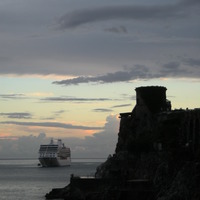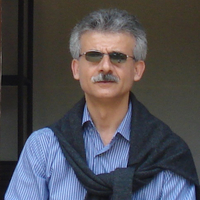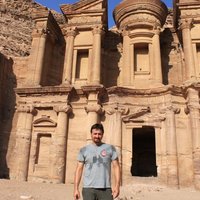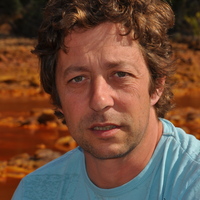Environmental effects caused by the Mw 8.2, September 8, 2017, and Mw 7.4, June 23, 2020, Chiapas-Oaxaca (Mexico) subduction events: Comparison of large intraslab and interface earthquakes
Quaternary International, Mar 1, 2023
Earthquake Environmental Effects (EEEs) such as surface faulting, landslides, liquefaction and ts... more Earthquake Environmental Effects (EEEs) such as surface faulting, landslides, liquefaction and tsunamis are widely distributed following strong seismic events and may account for a significant part of the overall damage. Here, we investigate EEEs generated by two earthquakes with different source parameters, both occurring along the Mexican subduction zone: the Sept. 8, 2017, Mw 8.2, moderate depth, normal fault, intraslab event; and the June 23, 2020, Mw 7.0, shallow depth, thrust fault, interface event. We document all the EEEs for each event, assign an intensity value using the Environmental Seismic Intensity (ESI-2007) scale, and derive the macroseismic fields. Finally, we compute the attenuation of intensity with distance and we compare it with other subduction zone earthquakes worldwide, demonstrating the repeatability of EEEs. This work represents the first application of the ESI-2007 scale to an intraslab earthquake and documents its wide applicability in different seismotectonic settings. We argue that EEEs provide useful information that should not be neglected in seismic hazard assessment procedures










Uploads
Papers by sabina porfido
(PDF) Resilienza in Irpinia. Analisi e bilancio nell’Alta Valle del Calore dopo il terremoto del 1980. Available from:
Sabina Porfido.*,** Efisio Spiga****
Giuliana Alessio**, Rosa Nappi**
CNR-ISA*, INGV**, Osservatorio
Vesuviano***, Libero Professionista****
........................................................................................................
Il terremoto dell’Irpinia e della Basilicata può essere considerato attualmente il più forte sisma registrato in Italia negli ultimi 100 anni, fu caratterizzato da una intensità epicentrale I0=X MCS, I0=X ESI e magnitudo ML=6.9. Il sisma causò circa 3000 vittime e danni in 800 paesi ubicati soprattutto a ridosso dell’Appennino meridionale. Castelnuovo di Conza, Conza della Campania, Lioni, Santomenna, Sant’Angelo dei Lombardi, Caposele, Calabritto, San Mango sul Calore, San Michele di Serino, Pescopagano, Guardia dei Lombardi, Laviano, Sant’Andrea di Conza, Senerchia e Teora, furono quasi completamente distrutti. Numerosi e devastanti furono gli effetti sull’ambiente naturale quali fenomeni di fagliazione superficiale ma anche e soprattutto fenomeni franosi, fratture nel suolo, variazioni idrologiche e fenomeni di liquefazione.
Il grave livello di danneggiamento e gli estesi fenomeni di dissesto idrogeologico, hanno in molti casi condizionato la ricostruzione, talvolta sconvolgendo l’assetto degli originari insediamenti abitativi. In quest’ottica sono stati eseguiti studi di dettaglio per alcuni dei paesi più gravemente colpiti dal terremoto: Conza della Campania, San Mango sul Calore, Calitri, San Michele di Serino e Romagnano al Monte. Di questi, Conza della Campania e Romagnano al Monte, sono stati delocalizzati e ricostruiti completamente ex-novo, non senza conseguenze socio-economiche per la popolazione, mentre San Mango sul Calore, Calitri e San Michele di Serino, hanno cercato di recuperare il patrimonio edilizio esistente e di ricostruire con prevalenza di strutture in cemento armato rispettando l’originale assetto urbano.
Valente E.1, Ascione A.2, Cozzolino M.1 & Porfido S.3
Based on the intensity and frequency of the past earthquakes , currently the city of Naples is classified in the second seismic category, that means it is characterized by "seismicity of medium energy".
The analysis of the available seismic catalogues shows that in the last millennium more than a hundred earthquakes have hit Naples, with intensity I> III degree MCS scale over the felt level. Ten of these events have exceeded the damage level, a few of these with intensity greater of VII MCS. The strongest earthquakes of 1456 (I0=XI MCS), 1688 (I0=XIMCS), 1805 (I0=XMCS), occurred in the Apennines chain, respectively between the L’Aquila and Benevento cities, in Sannio area and in Molise region, produced devastating effects in the urban contest of the city of Naples, reaching levels of damage equal to VIII degree MCS scale. In the twentieth century the city of Naples was hit by three strong earthquakes with epicenters between the Irpinia and Basilicata regions, in the Southern Apennines, respectively occurred in 1930, 1962 and 1980. The last one is still deeply engraved in the collective memory, for the number of about 3000 victims, and with the almost total destruction of some appenninic villages.
This brief review of the strong Apennines earthquakes that rocked Naples, highlights how important is to know the seismic history of a site for understanding and disseminating information about the local seismic hazard level. The seismic hazard of Naples is decisive not only for implementing all appropriate measures to reduce seismic risk, but also for planning measures of prevention, useful for the preservation of the rich architectural heritage.
It was destroyed by the earthquake of 1694 and severely damaged by those of 1732, 1930 and 1980.
The earthquake of November 23rd, 1980 once again highlighted the territory’s extremely unstable conditions, so the Municipal Administrations opted for the reconstruction of the village in another more secure location from a geological point of view, called “Piano di Zona”, which was already identified in a previous urban planning plan, following the 1930 earthquake.
As a matter of fact, there are currently two Bisaccia: the old one, an ancient village recovered around the ducal castle and the new Bisaccia of the Piano di Zona, the latter almost completely rebuilt according to the urban plan drawn up by architect Aldo Loris Rossi.
Our journey on post-earthquake reconstruction essentially focused on Bisaccia Nuova, in search of that utopian city designed by Aldo Loris Rossi: a city that is not a village, with the heights and distances that should be typical of a site mostly exposed to earthquakes. A city not understood, which many consider unlivable, a futuristic city, which doesn’t combine in any way the past and present, the past still confined to the old site.
The photographic research is focused on the urban landscape as a whole, in the details, from the almost spatial structures of the church, to the houses that develop in a circular way around the central nucleus; it also focuses on the aspects related to the viability of the main access roads, and on what has remained of the 79 IACP residential houses in Boscozzulo, where currently the majority of the houses has been demolished, leaving as witnesses only their ruins, in evident contrast with the beauty of the landscape immersed into splendid clear skies.
The images intend to document the different steps of the reconstruction: some photos date back to over twenty years ago, the others relate to more recent times.
The new Bisaccia village, immersed in the mountains of the Apennine ridge and the sound of the wind turbines far away, represents an element of extreme contrast with all its reinforced concrete construction: it demonstrates how futuristic architecture remains cut off from the village’s natural surroundings.
Perhaps this makes Bisaccia such an interesting place, a fascinating village, lost in the wind, not accepted by its inhabitants and the local community.
Bisaccia, piccolo paese a 860 metri sul livello del mare, situato in provincia di Avellino, è certamente caratterizzato da aspetti particolarmente controversi, che ne hanno condizionato pesantemente lo sviluppo: da un lato le frane ed i terremoti, dall’altro gli interventi di ricostruzione post-disastro. Paese perennemente in frana per la natura stessa del terreno su cui sorge, costituito per lo più da un piastrone conglomeratico poggiante sui litotipi delle Argille varicolori, è tra i paesi ammessi a consolidamento già nel1917. Fu distrutto dal terremoto del 1694 e gravemente danneggiato da quelli del 1732, 1930 e 1980. Il terremoto del 23 novembre 1980 mise in evidenza ancora una volta le condizioni di fragilità del territorio, per cui le Amministrazioni comunali optarono per la ricostruzione del paese in altro sito più sicuro dal punto di vista geologico, denominato “Piano di Zona”, già individuato in un precedente piano regolatore a seguito del terremoto del 1930. Di fatto, attualmente esistono due Bisaccia: quella vecchia, antico borgo recuperato intorno al castello ducale e la Bisaccia nuova del Piano di Zona, quest’ultima quasi completamente ricostruita sulla base del piano urbanistico redatto dall’architetto Aldo Loris Rossi. Il nostro viaggio sulla ricostruzione post terremoto si è concentrato essenzialmente su Bisaccia Nuova, alla ricerca di quella città utopica disegnata da Aldo Loris Rossi: una città che non è un paese, con le altezze e le distanze che dovrebbero essere tipiche in zona sismica. Una città non compresa, che molti considerano non vivibile, una città futuribile, che non coniuga in alcun modo il passato, confinato nel borgo antico. La ricerca fotografica è focalizzata sul paesaggio urbano colto nel suo insieme, nei particolari, nelle strutture quasi spaziali della chiesa, nelle abitazioni che si sviluppano in modo circolare intorno al nucleo centrale, sulle strade di accesso; si concentra inoltre su quello che resta delle 79 case popolari. Spiga E. & Porfido S. (2020) Bisaccia piano di zona- Blurb ISBN 978-1-71-555296-1 https://it.blurb.com/b/10308955-bisaccia-piano-di-zona
Como una respuesta a esta problemática, la USAC, atendiendo a su misión constitucional, ha trabajado bajo la filosofía de acción académica y compromiso social, además de las universidades que forman parte de esta Red Centroamericana, las cuales se han integrado a través de una eficiente gestión del conocimiento que ha permitido la articulación de la trilogía: investigación, docencia y extensión, ejes fundamentales que han propiciado el análisis, la reflexión y el debate científico para interpretar las dinámicas físico ambientales que inciden en el fenómeno. Todo ello ha sido posible gracias a un largo proceso de cooperación con la Universidad de Palermo y se sintetiza en esta publicación, la cual se pone desde ya a disposición de investigadores, organizaciones civiles, entidades estatales, agencias de desarrollo y gobiernos locales como una útil herramienta en los procesos de planificación y gestión de asentamientos humanos y del territorio.
Por último, pero no menos importante, es oportuno agradecer el apoyo obtenido en este proceso por parte de la Cooperación Italiana para el Desarrollo, la Universidad de Palermo y el Consejo Nacional de Investigaciones de Italia -CNR/IGG-, así como el Consejo Superior Universitario Centroamericano y cada una de las universidades integrantes, quienes de forma articulada han logrado, a través de la Red Interuniversitaria en Análisis y Evaluación de la Peligrosidad Natural en Centroamérica, una integración centroamericana con interacción internacional, propiciando que el conocimiento científico se valide en un ámbito global para contribuir en la búsqueda de soluciones a problemas locales.
Benedetto Abate valerio Agnesi Chiara Cappadonia Antonio Caprai Christian Conoscenti eliana esposito
Giuseppe Giunta miguel Hernández reynaldo López Giovanna maselli silvia orioli Sabina Porfido
Dionisio rodríguez edoardo rotigliano silvio rotolo Attilio sulli marvin valle Crescenzo violante
The housing emergency due to the violent November 23, 1980 Irpinia-Lucania earthquake was really dramatic not only for the communities in the epicentral areas, but also for the villages located relatively further away, that suffered a much lower level of destruction. This is the case of my native land, San Potito Ultra, a small village of about 1500 inhabitants in the province of Avellino (Campania region), located in the earthquake far field, where 200 people were left homeless. The dreadful situation induced the local administrations to make up for the homeless by adopting temporary measures such as the installation of various types of prefabricated buildings not far from the village centre. Among these certainly the most singular, for shape and size, were the thermo-higloos (dome house) of expanded polystyrene, which were a gift from the Sicily Region. About twenty of them were installed, and this solution that was supposed to be temporary, over time turned into almost permanent, in fact they were inhabited for over twenty years. The thermo-igloos, or rather what remained of them, were completely dismantled only a few years ago, in 2015. This book collects several photos of how were these igloos and what is still visible today in the location identified by the geographical coordinates 40°55’28.54” N - 14°52’00.42” E It shows images for our memory, in order to not completely remove the tragedy of that moment, moreover it makes a contribution to future memory.
volumi contengono i risultati di un confronto tra studiosi ed esperti di discipline umanistiche e scientifiche sul tema della baia di Napoli. Strategie integrate per la conservazione e la fruizione del paesaggio culturale. Della baia di Napoli, la cui immagine è celebrata in tutto il mondo attraverso innumerevoli vedute, fotografie, dipinti, fino a farne diventare un paradigma di paesaggio culturale nell'immaginario storico collettivo, sono state indagate risorse e criticità, connotazioni fisiche ed espressioni immateriali, afferenti alle radici culturali più antiche del mondo che ha avuto nel Mediterraneo il suo straordinario svolgimento. La raccolta pluridisciplinare trova posto nei due volumi: il primo riguarda diversi ambiti tematici, dalla natura alla geostoria, dall'urbanistica e l'architettura all'archeologia, fino alle diverse forme di espressione culturale. Il secondo volume accoglie le questioni interpretative del paesaggio culturale, indagandone natura e declinazioni in un'ottica di valorizzazione.